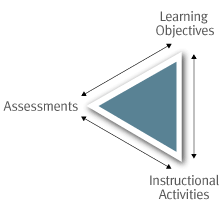It is very important for assessments
to be aligned with the learning objectives and instructional materials because
they all work together and support each other. Objectives and assessments are
intertwined and both of these should be clarified before you begin to figure
out what type of instructional materials you will use. While objectives state
what is expected, assessment provides tools to determine whether the learning
outcomes have been reached (Lamb, Annette, 2012-2014)."
Reasons your course should be
aligned:
-
First, alignment increases the probability that we will
provide students with the opportunities to learn and practice the
knowledge and skills that will be required on the various assessments we
design.
- Second, when assessments and objectives are aligned,
“good grades” are more likely to translate into “good learning” (Eberly,
2014)."
In order for your course to be aligned you will need to make sure that the learning objective, assessments, and instructional strategies are aligned in your course. This is the only way that you will have effective learning in your course.
"A framework for reflection - The Triangle of Effective LearningBiggs (2003) argues that effective instruction is the result of the alignment of Learning Activities and Assessment with the intended Learning Outcomes or Objectives (Carey, Linda, 2014)."
When reflecting on your courses
ask yourself these simple questions:
-
"Do the learning outcomes flow from the previous
session and do they progress students' knowledge, understanding and skills
(Carey, Linda, 2014)?" Make sure that the students are taking away
all the information that you wanted them to absorb from the course.
- Do the planned and enacted learning activities move
students' learning towards the intended outcomes (Carey, Linda, 2014)?”
You will have to think to yourself, what instructional materials can I
provide that will strengthen the students’ knowledge of the learning
objectives and get them ready for the assessments.
- Do the planned and enacted assessment activities allow
students to demonstrate the knowledge, understanding and skills
highlighted in the learning outcomes (Carey, Linda, 2014)?" It is
important to create assessments that will showcase that the students
attain the learning objectives that you set forth.
"If assessments are misaligned
with learning objectives or instructional strategies, it can undermine both
student motivation and learning (Eberly, 2014)." The student’s attention
will most likely start to center their attention around whatever will direct
them to obtain a good grade, which in fact they should be concentrating on
learning what is critical.
References
Eberly Center, What is the difference between formative and summative assessment (2014). Carnegie Mellon. Retrieved from http://www.cmu.edu/teaching/assessment/basics/formative-summative.html
Lamb, Annette. Inforamtion Inquiry: Instructional Strategies for Library & Information Professionals (2012-2014). Retrieved from http://eduscapes.com/instruction/8.htm





